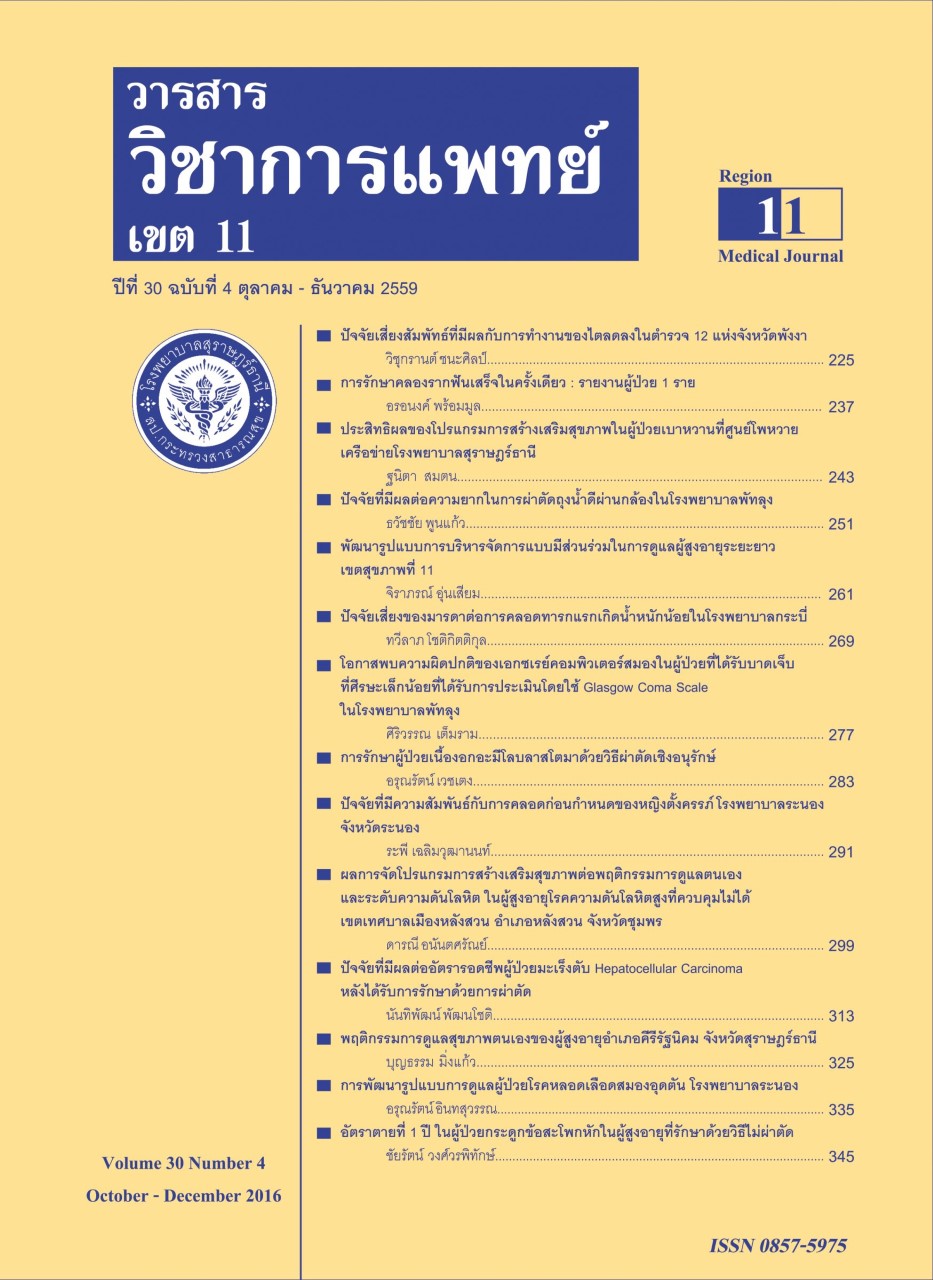Factors associated with preterm birth among pregnant women at Ranong Hospital
Keywords:
preterm birth, associated factorsAbstract
The study was retrospective. It aimed to identify factors associated with preterm birth at Ranong Hospital. By studying the receipt of prenatal care and medical records of mothers who gave birth at Ranong Hospital . A separate group of mothers who gave birth prematurely before 37 weeks gestation and 145 mothers who gave term birth to equal amount on January 1, 2015 - December 30, 2015. The social demographic data were collected and analyzed
by using Chi-Square tests.
The study indicated that most mothers aged 21-25 years (23.79%), the average age of mothers was 27.27 years. Thai race to 100%. Most graduates of secondary education, 48.62 %. 50% were housewives. 57.44 kg average weight before pregnancy. A BMI of 19.8 to 26 (60.69%). There are no smoking, drinking 100 %. No abortion history, Preterm birth records, vaginal bleeding pregnant and no underlying disease before pregnancy percent 87.24, 94.83 and 100, 98.86 respectively. Among the factors that were associated with preterm birth in Ranong Hospital significant 0.05 include weight before pregnancy (x2= 0.13 p = 0.022), history of preterm birth before (x2= 15.82 p = 0.000). , antenatal care (x2= 34.75 p = 0.000), multiple gestation (x2= 14.71 p = 0.000) and increased maternal weight below the threshold (x2 = 40.14 p = 0.000).
The results of this study can be adapted to provide in the screening pregnant women who are at high risk of preterm birth. Education , monitoring and early intervention can be applied to prevent preterm birth.
References
2. Liu, L.H., Counsen, S., Perin, J., scott, S., Lawn, J., Ruden, I.,Campbell, H., Cibulskis, R.,Megying, L.,et al. (2012). Global, regional and national causes of child mortality: and updated systematic analysis for 2010 with time trends since 2000.The Lancet, 379, 2151-61.
3. Lawn, J. E., Kerber, K., Enweronu-Laryea, C., & Cousens, S. (2010). 3.6 Million neonatal deathswhat is progressing and what is not? Semin perinatal, 34, 341-86.
4. Anumba, D.O. (2007). Management of woman with previous preterm birth.Obstetrics. Gynecology and Reproductive Medicine. 17, 188-91.
5. ALLEN, M, C. (2008). Nerodevelopmental outcomes of preterm infants. Current Opinion in Neurology.21(2), p. 123-8.
6. Lowdermilk , D.L., & Perry, S.E. (2006). Maternal nursing. St. Louis: Mosby: p.769-82.
7. Blencowe et al. (2013). Reproductive Health, 10 (Suppl 1): S2 Retrieved June, 10 2015, from http://www.reproductive –health-journal.com/content/
10/S1/S2
8. Lindsay, P. (2004). Preterm Labour. In H. Christine, & M. Sue (Eds.), Mayes, midwifery: A text for midwives (13th ed.) Toronto: Bailliere Tindall: p.853-61.
9. Ifeoma O., Keelin O., & Louise K., (2012). Clinical Risk Factors for Preterm Birth. Retrieved June, 25 2015 from http://cdn.intechopen.com/pdfswm/27121.pdf
10. ศูนย์ข้อมูล โรงพยาบาลระนอง. (2558). รายงานประจำปีงบประมาณ 2555-2557. ระนองโรงพยาบาลระนอง.
11. Schieve, L.A., Cogswell, M.E., & Scanlon, K.S. (1999). Maternal weight gain and preterm delivery: Differential effects by body mass index. Epidemiology,10 (2), 141–7.
12. Goldenberg, R.L., Culhane, J. F., Iams, J.D., & Romero, R. (2008). Epidemiology and causes of preterm birth. Lancet, 371, p.75–84.
13. Muglia, L.J., & Katz, M. (2010). The enigma of spontaneous preterm birth. N Engl J Med, 362: 529–35.
14. Plunkett, J., & Muglia, L. J. (2008) . Genetic contributions to preterm birth: implications from epidemiological and genetic association studies. Ann
Med, 40: 167–95.
15. อรวรรณ อารักษ์สมบูรณ.์ (2543). ปัจจัยที่เกี่่ยวข้องกับการคลอดก่อนกำหนด. วิทยานิพนธ์วิทยาศาสตร์มหาบัณฑิต. สาขาการเจริญพันธ์และวางแผนประชากร,
บัณฑิตวิทยาลัย มหาวิทยาลัยมหิดล.
16. Iams, J.D., Goldenberg, R.L., Mercer, B.M., Moawad, A., Thom, E., Meis, P.J., McNeills, D., Caritis, S.N., Miodovnik, M., Thurnau, G.R., Bottoms,
S.E., & Roberts, J.M. (1998). The Preterm Prediction Study: recurrence risk of spontaneous preterm birth. National Institute of Child Health and
Human Development Maternal-Fetal Medicine Units Networks. American Journal of Obstetrics and Gynaecologists. 178(5), p. 1035-40.
17. พรรณี พิณตานนท์, กาญจนา คำดี, อัจฉรา วโรภาษ,สุรพันธ์ แสงสว่าง. ปัจจัยที่มีผลต่อการเจ็บครรภ์และการคลอดก่อนกำหนดในโรงพยาบาลส่งเสริมสุขภาพ
ศูนย์อนามัยที่10 เชียงใหม่ Retrieved March 12, 2014 fromhttp://webcache.googleusercontent.com/search?q=cache:aqWXNvPWtCkJ:kc enter.anamai.
moph.go.th/download.php%3Finfo_id%3D795%26download_file%3Ddoc/0782. 98b 04f765dcc3d0b4e2ec15d6a32.docx+&cd=2&hl=th&ct=clnk&gl=th
18. ฐิติกานต์ ณ ปั่น. ( 2557). ปัจจัยที่มีผลต่อการคลอดก่อนกำหนดของหญิงตั้งครรภ์ โรงพยาบาลอมก๋อย จังหวัดเชียงใหม่. วารสารสาธารณสุขล้านนา, 10(2):142-50.
19. สมนึก จิรายุส.(2551). ปัจจัยเสี่ยงของการเกิดทารกแรกเกิดน้ำหนักน้อยและการคลอดก่อนกำหนดในหญิงตั้งครรภ์ที่ฝากครรภ์ไม่ดี.ขอนแก่นเวชสาร, 32(7):121-6.
20. Blondel, B., Macfarlane A., Gissler, M., Breart, G.,& Zeitlin, J. (2006). Preterm birth and multiple pregnancy in European countries participating in
the PERISTAT project. BJOG. 113: 528–35.
21. Krampl, E., & Klein, K. (2007). Prematurity in multiple pregnancies. Gynakologisch Geburtshilfliche Rundschau, 47(2): 64-9.
22. Carmichael, S.L., & Abrams, B. (1997). A critical review of the relationship between gestational weight gain and preterm delivery.Obstetrics and
Gynecology, 89(5): 865–73.






